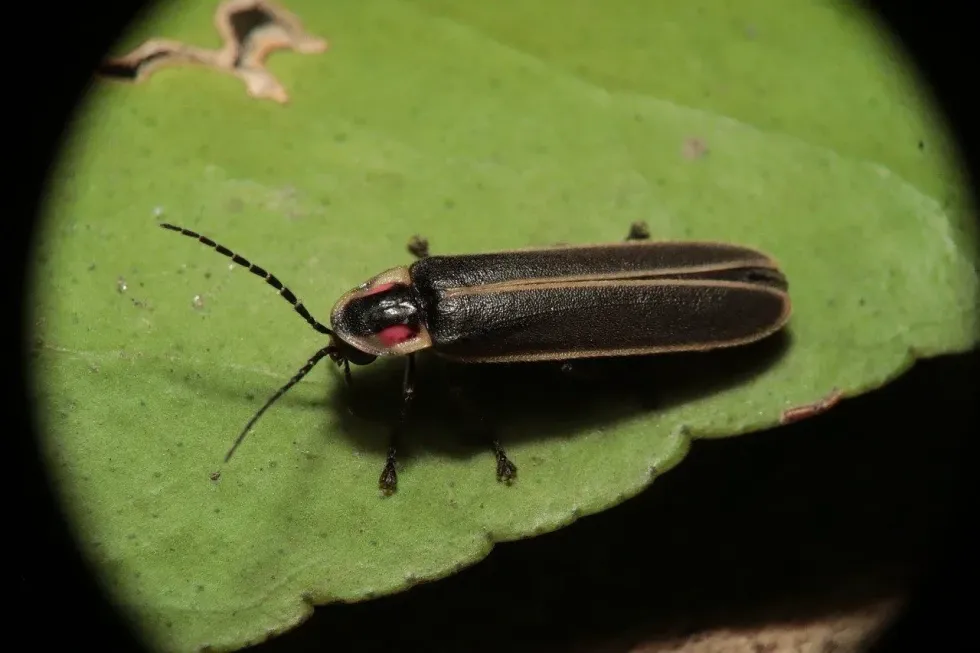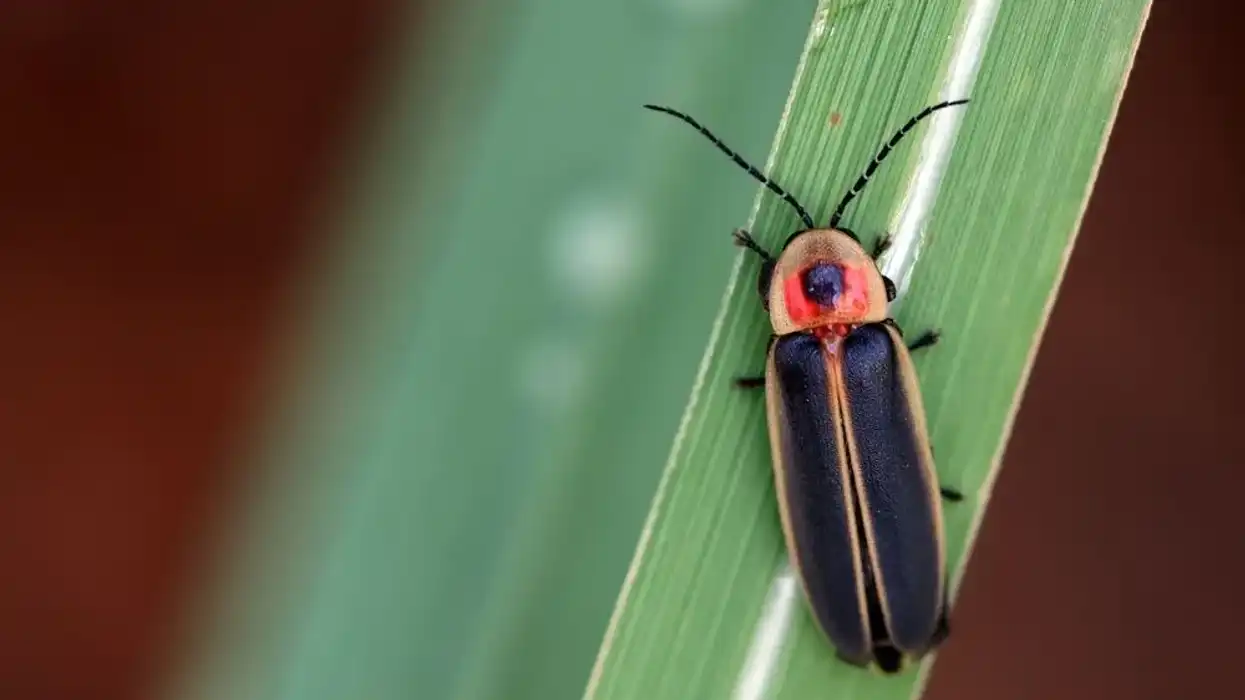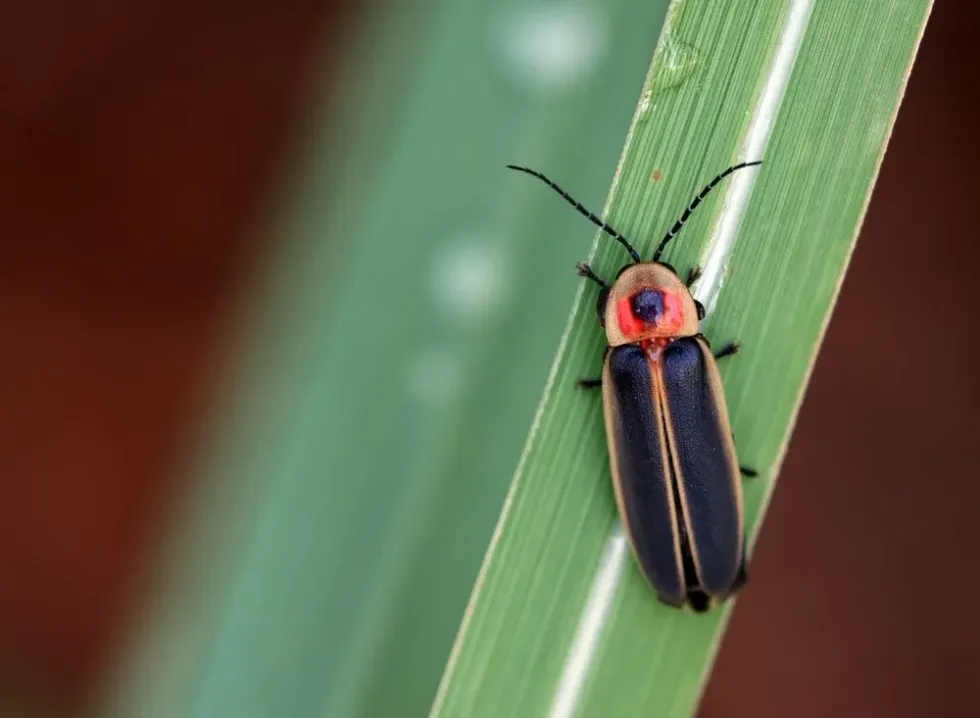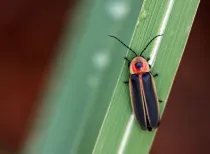Fun Lightning Bug Facts For Kidssna

Have you ever caught a firefly in a glass jar to see how it glows? Was it not fascinating to go out for a stroll on a warm summer evening and see a light show, with dozens of fireflies lighting up the roadside?
A lightning bug, more commonly known as a firefly, is, in fact, a beetle that glows in the dark.
There are over 2,000 species of fireflies spreading across North America, Asia, and Europe. They are mostly found in temperate and tropical climates.
These winged, dark brown or black bodied beetles with yellow or orange stripes have an organ under their abdomen that allows them to emanate light. The fireflies use this light to attract mates, the flashing pattern being unique to each species.
Some firefly species also use this light as a defense mechanism or to lure their prey into a trap.
Fireflies can be categorized as omnivores. In their larval stage, they feed on worms, ants, slugs, and snails from the ground. But as they transition into adults, they mostly consume nectar and pollen. To find more interesting facts about this fascinating creature, read on.
This article includes information on the lightning bug life cycle, lightning bug scientific name, lightning bug symbolism, lightning bug fly pattern, lightning bug flying mechanism, lightning bug lifespan, lightning bug vs firefly.
You may also check out the fact files on giant water bugs and stink bugs from Kidadl.
Lightning Bug Interesting Facts
What type of animal is a lightning bug?
Lightning bugs, also known as fireflies, belong to the family of insects and are in fact, beetles. These soft-bodied insects have a unique organ under their abdomen that allows them to glow at night, which is due to a chemical reaction caused by a compound called luciferin. Most firefly species are nocturnal, but some species are also diurnal.
What class of animal does a lightning bug belong to?
A lightning bug belongs to the class of insects under the phylum Arthropoda, just like a wheel bug.
How many lightning bugs are there in the world?
Belonging to the Lampyridae family, there are over 2,000 species of fireflies spread throughout the world. We can find the most diversified firefly species in America and Asia and also in some parts of Europe. In the United States, the most common species found is Photinus.
There are some species of firefly that are predators. Females of the Photuris species use aggressive mimicry to lure in the Photinus males by matching their blinking patterns. So, Photuris females are sometimes also called ‘femme fatales’.
Where does a lightning bug live?
The lightning bug lives in temperate and tropical climates. They are found mostly in marshes, wetlands, and woods where the females lay their eggs. Moist lands which are home to most insects and worms ensure that the underground larvae have sufficient food to feed on.
What is a lightning bug's habitat?
Fireflies are found in warm humid regions and though they do not live in water, they throng the areas near ponds, lakes, rivers, and marshes. They need moisture to breed and for the larvae to develop.
They are also found in dry places, so long the places are warm and damp. Fireflies thrive in warm and wet regions. So, most fireflies appear during summers.
Who do lightning bugs live with?
Fireflies live in hordes. First, you might spot one, then another, and in no time, the entire area is lit up with fireflies. In fact, in a single habitat, there can be many species of fireflies living together.
How long does a lightning bug live?
The firefly life cycle has four stages- egg, larva, pupa, and adult. The adult female lay their eggs in summer. The fireflies spend most part of their lifetime in the larval stage.
Lightning bug larvae take about one to two years to mature into adults. The lightning bug larva can produce light. Like the adults, they too have glowing light organs.
So, they are also called glowworms. The larvae are predators and feed on underground snails, ants, and worms.
Adults live for a period of about twenty-one days, during which time they mate, breed, and die. During their adult stage, they feed on nectar and pollen but some fireflies can even go without eating during this stage. So, we can conclude that the lightning bug lifetime is fairly short.
How do they reproduce?
Firefly flashes are romantic gestures that fireflies use to attract mates. Adult fireflies live for a period of at most two weeks.
During this time, the male fireflies emit flashes of light to attract the females. If a female, perched atop a plant, is impressed by the light flash of the male, it accordingly responds. Thus, the male and the female mate.
The females lay the eggs on moist grounds. The eggs hatch in about two weeks and result in the formation of the larva. The larval stage is the longest in the lifetime of a firefly which can be up to two years. The larva then eventually pupate and transforms into a well-formed adults after a few weeks.
What is their conservation status?
The firefly population has most certainly decreased over the years. Fireflies blinking in the twilight are no longer a common sight.
The threats are, as in so many other cases, humans and their activities. Studies have shown that the main cause of the dwindling of the firefly population is their loss of habitat, light pollution, and climate change.
What can be done to save these rare species of beetles is to preserve the locations where the fireflies are known to thrive. What a pity it would be, otherwise, if the firefly lights from these astounding creatures disappear altogether from the face of the Earth!
Lightning Bug Fun Facts
What do lightning bugs look like?

Lightning bugs are bioluminescent insects. They have a soft body and an organ under their abdomen that gives off yellow, orange, green, or neon lights in the dark. They have compound eyes and up-close, it looks like they have a glowing rear.
How cute are they?
Lightning bugs are black or brown smooth-bodied beetles that when looked at individually, might not exactly be called cute. But if you see all of them twinkling in the twilight, there might not be a cuter sight than that of the glowing firefly light.
How do they communicate?
The fireflies communicate through their lights. There are some fireflies that glow while there are others that flash.
Those species of fireflies that do not glow use pheromones for communication. The fireflies use their light to attract mates, to lure in prey, and also use it as a defense mechanism to thwart enemies. The bioluminescence is caused due to the reactions of an enzyme called 'luciferase'.
The most common way to communicate between the male and female fireflies is by using their unique blinking patterns to attract each other.
How big is a lightning bug?
The flattened body of a firefly varies in size and can grow up to a maximum of 0.98 in (2.48 cm) in size. However, the biggest fireflies, which are the females of the Lamprigera species can grow as big as the palm of a human hand.
How fast can a lightning bug move?
There is no such data that speaks about the exact speed in which a firefly moves. A male firefly is winged and moves around blinking its light to find potential mates. When it spots a light that attracts it, the female reciprocates with the same flash pattern. This is how the male and the female mate.
How much does a lightning bug weigh?
The adult lightning bug usually weighs around 20 mg.
What are the male and female names of the species?
Fireflies do not have separate names for their male and female counterparts.
What would you call a baby lightning bug?
Before being adults, the lightning bugs are called larvae, and they reside underground. Some larvae of fireflies glow as well and are called glowworms.
What do they eat?
The larva of the fireflies grows from the eggs that the females hatch. During this stage, they feed on ants, snails, worms, and larvae of other insects by injecting them with fluid.
Once they grow to their fullest, they emerge as adults and live off nectar and pollen. There is also the predator species of fireflies called Photuris which mimic the mating light of males from other species to feed on them.
Are they dangerous?
The firefly larva is predatory and feeds off underground warms and other insects. Fireflies can also be poisonous.
The attack from these predators can produce harmful chemicals that are hazardous to animals and birds and are not good for humans as well. One fun fact. The Photuris females can mimic a wide range of flash patterns of other species to lure in the males.
These Photuris predators then acquire a certain toxin from the males called 'lucibufagin'. They deposit this toxin into their eggs which are then used as a chemical defense.
Would they make a good pet?
No. Fireflies cannot be used as pets for they are mere bugs. However, you may bottle up a firefly to witness the astounding phenomena of its blinking organ.
Did you know...
The fact is fireflies and lightning bugs are typically the same insect but are referred to differently depending on the place they are found in. In Northeast and West America, these glowing bugs are called 'fireflies', while in the Midwest, they are called 'lightning bugs'.
If you are wondering whether lightning bugs still exist, yes. They do exist. However, their numbers have drastically gone down over the years.
Scientists attribute this decline to human activities that have destroyed their habitats. Also, due to the increase in the use of artificial lights and climate change factors, their numbers have dwindled.
The blinking fireflies are now a rarity. However, on occasional warm summer evenings, if we are lucky, we can still see flocks of fireflies adoring our garden corners, roadsides, in the woods, and near the lakes. It is always a mesmerizing sight to watch.
What makes a lightning bug light up?
Fireflies have an organ underneath their abdomen that allows them to glow. However, out of the 2,000 species of fireflies, not all the species glow.
The glowing of the fireflies is the result of a pigment called luciferin which mixes with oxygen, a chemical called Adenosine Triphosphate(ATP), and a special enzyme called luciferase to produce light. The light of a firefly is, therefore, a result of a chemical reaction due to which the organ below the abdomen ultimately glow.
They use this light to find mates or to use it against their prey or to defend themselves.
The light from the fireflies varies from species to species. Every species has its own light, which can be either yellow, green, orange, or neon.
Scientists have figured out a way to use luciferin in the medical field and in biotechnology. Luciferin is used in bioluminescent imaging.
Scientists use bioluminescent imaging as a tool to study ongoing biological processes inside the cells of small laboratory animals. Bioluminescent imaging can be used to detect the growth of brain tumors and other such anomalies inside a living cell.
How energy efficient are lightning bugs?
Lightning bugs are 100% energy efficient as the light produced by them is original, produced as a result of chemical reactions.
Here at Kidadl, we have carefully created lots of interesting family-friendly animal facts for everyone to discover! Learn more about some other arthropods from our stick bug facts and Christmas beetle facts pages.
You can even occupy yourself at home by coloring in one of our free printable lightning bug coloring pages.
We Want Your Photos!
More for You
Bachelor of Arts specializing in English Literature

Akinwalere OlaleyeBachelor of Arts specializing in English Literature
As a highly motivated, detail-oriented, and energetic individual, Olaleye's expertise lies in administrative and management operations. With extensive knowledge as an Editor and Communications Analyst, Olaleye excels in editing, writing, and media relations. Her commitment to upholding professional ethics and driving organizational growth sets her apart. She has a bachelor's degree in English Literature from the University of Benin, Edo State.
Postgraduate Diploma in Management

Sakshi RaturiPostgraduate Diploma in Management
Sakshi has experience in marketing strategy, social media planning, and recruiting industry experts for capstone projects, she has displayed a commitment to enhancing their skills and knowledge. She has won multiple awards, including a Certificate of Appreciation for Creative Writing and a Certificate of Merit for Immaculate Turut, and is always seeking new opportunities to grow and develop.
Disclaimer
1) Kidadl is independent and to make our service free to you the reader we are supported by advertising. We hope you love our recommendations for products and services! What we suggest is selected independently by the Kidadl team. If you purchase using the Buy Now button we may earn a small commission. This does not influence our choices. Prices are correct and items are available at the time the article was published but we cannot guarantee that on the time of reading. Please note that Kidadl is a participant in the Amazon Services LLC Associates Program, an affiliate advertising program designed to provide a means for sites to earn advertising fees by advertising and linking to Amazon. We also link to other websites, but are not responsible for their content.
2) At Kidadl, we strive to recommend the very best activities and events. We will always aim to give you accurate information at the date of publication - however, information does change, so it’s important you do your own research, double-check and make the decision that is right for your family. We recognise that not all activities and ideas are appropriate for all children and families or in all circumstances. Our recommended activities are based on age but these are a guide. We recommend that these ideas are used as inspiration, that ideas are undertaken with appropriate adult supervision, and that each adult uses their own discretion and knowledge of their children to consider the safety and suitability. Kidadl cannot accept liability for the execution of these ideas, and parental supervision is advised at all times, as safety is paramount. Anyone using the information provided by Kidadl does so at their own risk and we can not accept liability if things go wrong.
3) Because we are an educational resource, we have quotes and facts about a range of historical and modern figures. We do not endorse the actions of or rhetoric of all the people included in these collections, but we think they are important for growing minds to learn about under the guidance of parents or guardians.







